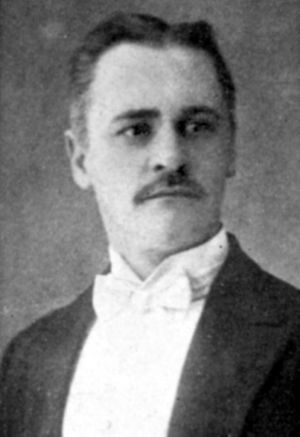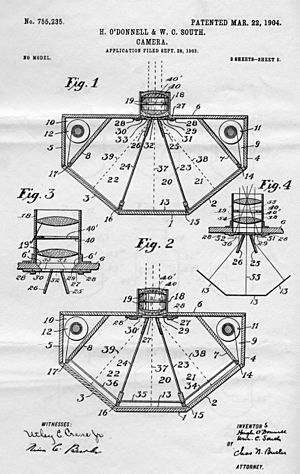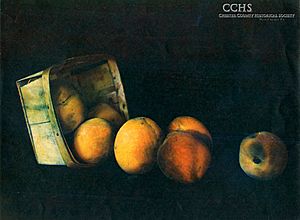William South (photographer) facts for kids
William C. South (1866–1938) was an inventor from Downingtown, Pennsylvania, in the United States. He created a special way to take color photographs in 1904. His system, called the Solgram, used a unique camera and a special printing method. The Solgram won many awards and was shown in many places. However, it never became a big money-maker in the busy world of photography.
Contents
Early Life and Education
William C. South was born to Mary Ella and George W. South. They lived in Berwyn, Pennsylvania. He went to the Spring Garden Institute in Philadelphia. There, he studied Art and Mechanical Engineering. William dreamed of becoming a landscape painter. He often used photographs to help him with his painting studies.
Starting in Photography
In 1891, William took charge of George W. Brown’s photo gallery. Later, he bought the gallery himself. He also took photos for businesses, like the Erie Railroad and International Navigation Co. steamship lines. He traveled a lot along the Erie Railroad to take pictures of different views.
The Solgram Color Process
Even though he was good at commercial photography, William wanted to try new artistic things. In 1904, he patented a color photography method. He called it "The Solgram." This process was similar to an older method called gum bichromate. It was also based on subtractive color, an idea first used by Louis Arthur Ducos du Hauron.
William worked with a partner named Hugh O’Donnell. They patented a special camera. This camera could take three separate pictures at the same time. Each picture used a different colored filter: purple, orange, or green.
These three pictures were then used to make a full-color photograph. Special paper was treated with three different colors: red, blue, and yellow. Each color was printed one layer at a time. It was important to line up each layer perfectly with the right negative.
William got patents for his camera and the Solgram process in several countries. These included the United States, Canada, Great Britain, France, and Belgium. On December 21, 1904, he started the Solgram Color-Photo Company. He began making printing kits in his factory in Downingtown, Pennsylvania. He showed off his new process through demonstrations and exhibitions.
The first time he showed the Solgram was on December 28, 1903. This was at a meeting of the Columbia Photographic Society in Philadelphia. He even won a bronze medal for his color photos. This award was given at the Pennsylvania exhibit during the 1904 World's Fair in St. Louis.
William wrote in his pamphlet, "The Solgram" A System of Color Photography: "There is no way to make pictures that show nature as truly as a watercolor painting by a master. So, I have made watercolor my goal."
Some people were interested in the Solgram process. These included the United States Department of Agriculture and artists like Charles E. Dana. However, the process had some problems. It took a lot of time to make a picture. Also, it was hard to line up the three negatives perfectly for printing. Because of these challenges, the Solgram Color Photo Company closed down by 1910.
Teaching Photography
William didn't give up. In 1910, he opened the Keystone School of Photography. It was in his building in Downingtown. He offered a nine-month course for $150. This course taught students how to run their own photo gallery. He also offered an advanced degree in "Artography." This was a word he made up for photography as a fine art. Of course, the Solgram color process was part of the lessons. He hoped to get 200 students, but he didn't. The Keystone School of Photography closed around 1912.
Later Life and Legacy
After closing his school, William South stopped working in photography. He started teaching music and making violins. He was a talented musician. He even led the Premier Concert and Dance Orchestra in Downingtown.
After his wife, Anna Boyle South, passed away in 1935, he moved to the Turk’s Head Inn in West Chester, Pennsylvania. William was known in West Chester for his collection of rare violins. This collection included famous instruments made by Stradivarius and Guarneri.
William C. South died in 1938 at the age of 72. He passed away in a nursing home in Berwyn. He did not have any children. He is buried at Laurel Hill Cemetery in Philadelphia.
Today, many of his patents, business papers, and photographs are kept at the Chester County Historical Society in West Chester. Some of his photographs were shown in 1989. This was at the Philadelphia Museum of Art. The exhibit was called “Legacy in Light: Photographic Treasures from Philadelphia Area Public Collections.” His work was also featured in the exhibit's catalog.




